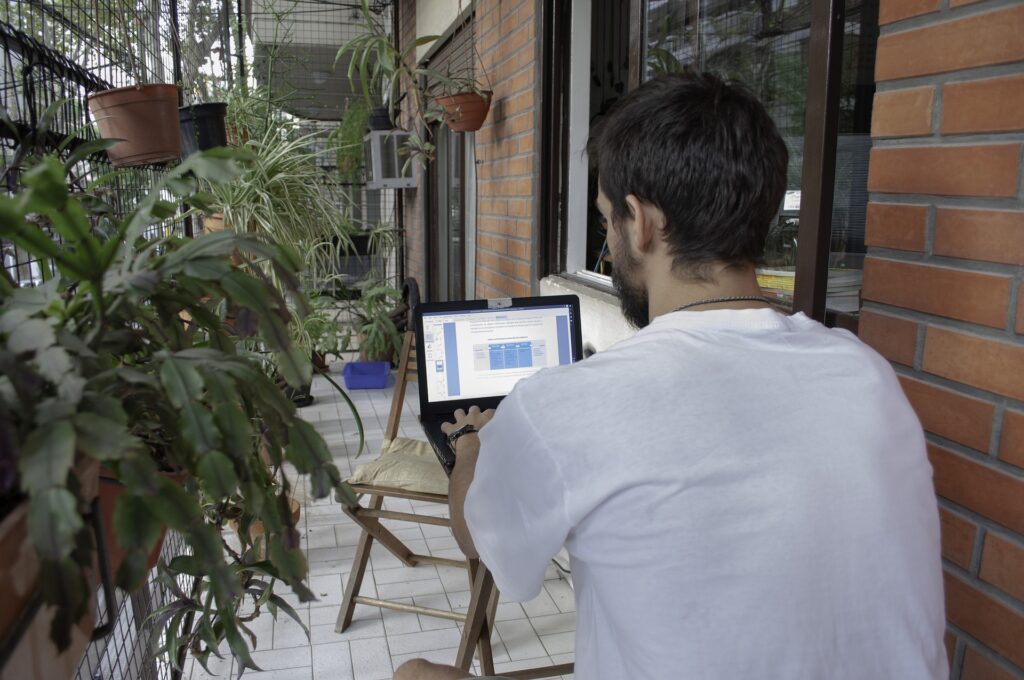Your home is your sanctuary, and you likely don’t consider it a place where you could get hurt. However, working from home involves significant health risks that are important to mitigate.
So what are the health risks of working from home? What new hazards should you expect? Most of all, what can you do to safeguard your well-being when making the switch from the office to telework?
Here are some common issues you might encounter, including how to remedy them, even though there are a large variety of remedies good for all types of pain.
1. Chronic Back Pain
The positive news is that relatively few work-from-home injuries result from cataclysmic events. The downside? Chronic pain issues can arise gradually, not coming into your awareness until they start hindering your productivity. By that point, the negative habits that lead to the ache are ingrained and challenging to break.
One of the most significant chronic pain issues occurs due to poor posture.
You might think, “Woohoo! I can work at home in my pajamas while lying on the couch.” While you can wear what you like — unless you’re one of those folks who need the psychological boost of wearing a suit at home — you need a quality ergonomic office chair. Pay attention to the amount of lumbar support, height, width and depth when making your selection.

2. Carpal Tunnel Syndrome
Another chronic condition that can arise from home office work is carpal tunnel syndrome. This painful disorder can significantly decrease your productivity if you type for a living because it affects your hand and wrists. While people often confuse it with arthritis, you can tell the difference by asking yourself if the joints in all your fingers hurt.
Carpal tunnel doesn’t affect the pinky finger, while arthritis typically impacts your entire hand.
Unfortunately, this occupational hazard is challenging to avoid if you are on the computer all day. However, you can minimize the impact by wearing a wrist brace and taking frequent stretch breaks throughout the workday.
3. Neck Strain
Looking down at your keyboard or tablet can cause bone spurs to develop at the base of your neck. This condition isn’t dangerous — but it is painful and can prompt headaches.
The fix is straightforward. Make sure you get a large enough monitor so you can clearly read your screen, and position it so you can see it while sitting upright with a correct posture.
4. Eye Strain
Can working at a computer all day hurt your eyes? Fortunately, there is no compelling evidence to indicate permanent eye damage from device use.
However, you could develop eyestrain, which leads to headaches, fatigue and blurred vision. Follow the 20/20/20 rule — every 20 minutes, look at something 20 feet away for 20 seconds.

5. Weight Gain
You might not feel like your activity level decreased all that much if you still hit the gym or use a fitness app. However, little things like walking from your car or to meetings burn calories, too. Pay attention to your scale. If you notice the number creeping, burn more calories throughout your day.
You can swap your chair for a fitness ball to engage your core, get a standing desk or set a phone timer to remind you to move for two to three minutes each hour.
6. Heart Disease
Heart disease can arise from various factors. Packing on the pounds can strain your heart, and so can an increased pressure to perform. Recent studies show chronic stress can cause changes in your brain that keep your blood pressure high, increasing your risk of a heart attack significantly.
Many people are feeling increased anxiety right now due to uncertainty — will your job and paycheck still be there tomorrow? If you are among them, practice techniques like meditation and yoga to relieve the pressure without resorting to unhealthy means like alcohol.
7. Burnout-Related Accidents
You might have heard that most accidents occur at home, but you probably thought these incidents only happened to those with mobility issues. However, heart disease isn’t the only adverse effect of chronic stress.
If you are tossing and turning all night, you don’t get the rest you need to stay fully alert. The next thing you know, you’re flying down the stairwell due to a misplaced Matchbox car your kid forgot to put away. Strive to get between seven and eight hours of sleep nightly.

8. Social Anxiety Disorder
Finally, isolation can do funny things to people. If you had social anxiety disorder before leaving the office, it could increase now that you don’t have to interact with others as often.
This avoidance behavior can create a negative feedback loop in your mind that makes you ever-more reluctant to mingle. Strive to socialize at least once a week, even if it involves a virtual happy hour.
Work From Home the Healthy Way
You wouldn’t think of telecommuting as an inherently dangerous activity, but working from home does have its hazards. Know the risks and use these tips to stay safe.



